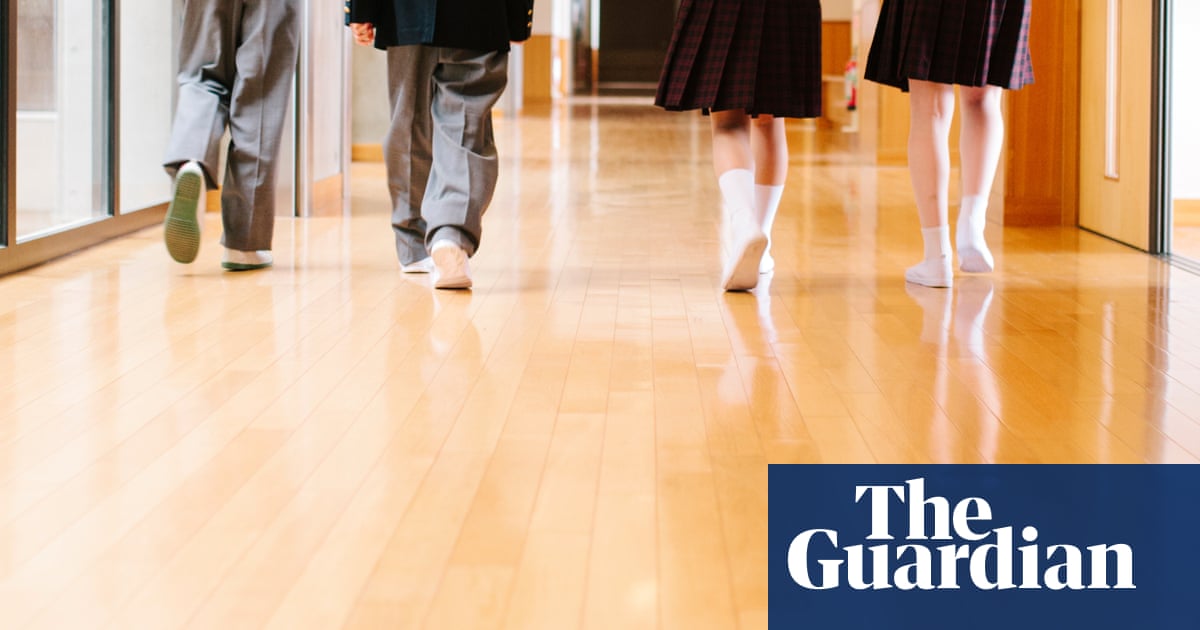“My chest was completely exposed and I felt embarrassed,” writes a Japanese girl after undergoing an annual health checkup at her middle school. Another says: “Before the exam our teacher told us we would have to lift up our tops and bra … I didn’t want to do it but I couldn’t say no.”
The testimony from two 13-year-olds, seen by the Guardian, is typical of the discomfort – and in some cases trauma – felt by children attending schools in Japan that can require boys and girls as young as five – and as old as 18 – to strip to the waist during health examinations.
It has sparked anger among parents and campaigners who have called on education and health authorities to end the practice before the new academic year begins in April.
Noriko Tabuchi, a city councillor in Matsuyama, first became aware of topless school health checkups through one of her English conversation class students. “She was 13 and hadn’t been able to tell her parents, but I could see she was troubled and asked her what was wrong,” says Tabuchi, who has since met other girls, all aged 12 and 13, who were told to strip to the waist by visiting doctors.
There is no unified policy on whether children should undress or remain clothed during the checkups, with local education boards left to decide in conjunction with visiting health professionals. Some schools require children to keep their bodies covered, while others insist that they remove their T-shirts and, among girls, bras. One western Japanese city senior high schools – whose oldest students are 18 – requires that pupils are topless during the checks.
Surveys show that most teachers want the requirement to end, while one poll of middle schoolchildren, aged 12-16, found that 95.5% of respondents were unhappy about removing their clothes. “The health exams can have serious repercussions for children,” says Akiyo Tanaka, a city councillor in Matsuyama. “Some of them continue to experience trauma into adulthood.”
‘Awful to remove clothes in front of strangers’
As the issue attracts the attention of media and national politicians, campaigners say they face resistance from the Japan Medical Association and education officials who are reluctant to take on the influential body. “In some cases, doctors, who are almost always men, have threatened to stop performing the exams if they are forced to change the procedure,” said a person familiar with the issue who asked not to be named.
“They insist it is impossible to conduct a proper exam if children are fully clothed. And the children are in no position to refuse. The schools are really concerned about this and want something to be done.”
The Japan Medical Association has not responded to the Guardian’s request for comment.
“Girls of my daughter’s age are embarrassed to talk about their bodies to their own parents,” says Chiyoko Suda, whose 13-year-old daughter begged her not to confront the school after she underwent a health check semi-naked. “So you can imagine how awful it is for them to have to remove their clothes in front of strangers.”
Some regions began conducting more invasive health checkups during the years of postwar austerity, when schools took on a bigger role in ensuring that children were healthy and properly fed.
Doctors have said topless exams are necessary to check for signs of atopic dermatitis, heart irregularities and other conditions. “Many doctors, especially senior ones, are conservative and they simply do not like to change their ways,” says Kentaro Iwata, a professor of infectious diseases at Kobe university hospital.
Asked if there was any medical basis for insisting that children remove their clothing to undergo a “proper” examination, Iwata said: “Not that I know of. It might slightly improve the quality of the sound of the heartbeat, but I do not think this contributes to improving children’s health.”
Complaints about the health exams have come from parents of children attending schools across the country, including Yokohama, where authorities said at least 16 primary schools required pupils to remove their tops and bras.
This is despite a notice issued by the education ministry at the start of the year requesting boards of education to “establish a medical examination environment with consideration for the privacy and feelings of the students” by allowing them to wear their PE kits or cover their upper bodies with a towel “to the extent that it does not interfere with the accuracy of the examination”.
The ministry also called for separate examinations for boys and girls, the use of partitions or curtains, for teachers and staff of the same sex as the children to be present, and for parents and guardians to be given advance notice that, in some cases, doctors may require children to raise their shirts to ensure an accurate diagnosis.
Kyoto city changed its policy under pressure from parents, telling schools that children should “in principle” be permitted to wear their underwear and PE kit. Other schools have followed suit.
“It would be better if the education ministry provided more specific guidelines so that local governments and schools can be consistent,” Satoshi Kodama, a professor and medical ethics specialist at Kyoto University, told the Mainichi Shimbun.
Mai Okumura said her middle school daughter had initially brushed off her health exam, during which she had to remove her T-shirt and bra. “When I asked her about it, she said it couldn’t be helped as the rules had been decided by adults,” says Okumura.
Sachiko Shimada’s daughter had been similarly reluctant to strip to the waist but felt unable to protest. “I was shocked when she came home and told me she had had to lift up her shirt and bra so that her breasts were showing,” Shimada says.
“This shows a total lack of respect for their privacy and dignity.”
The names of the children’s mothers have been changed at their request.
